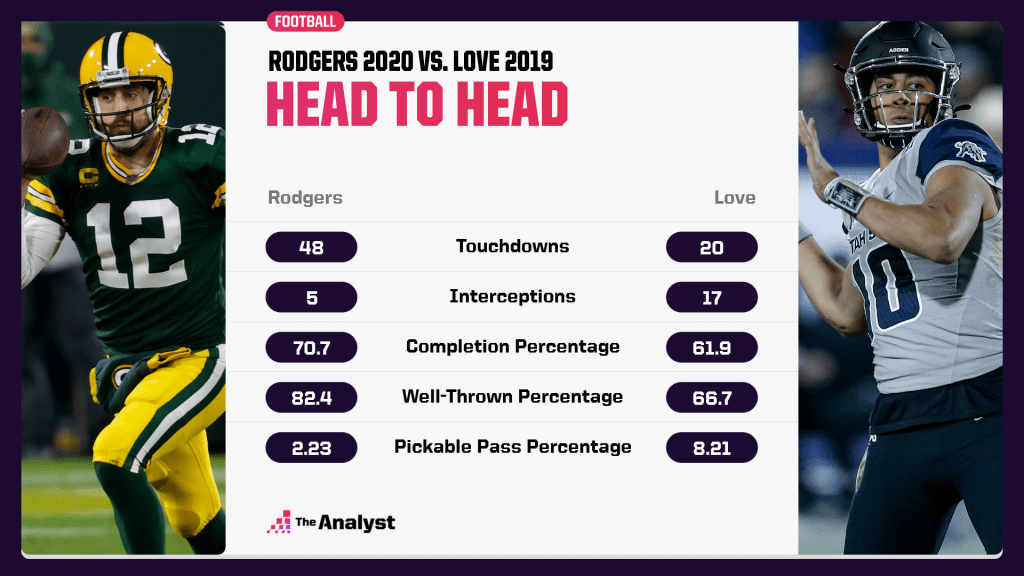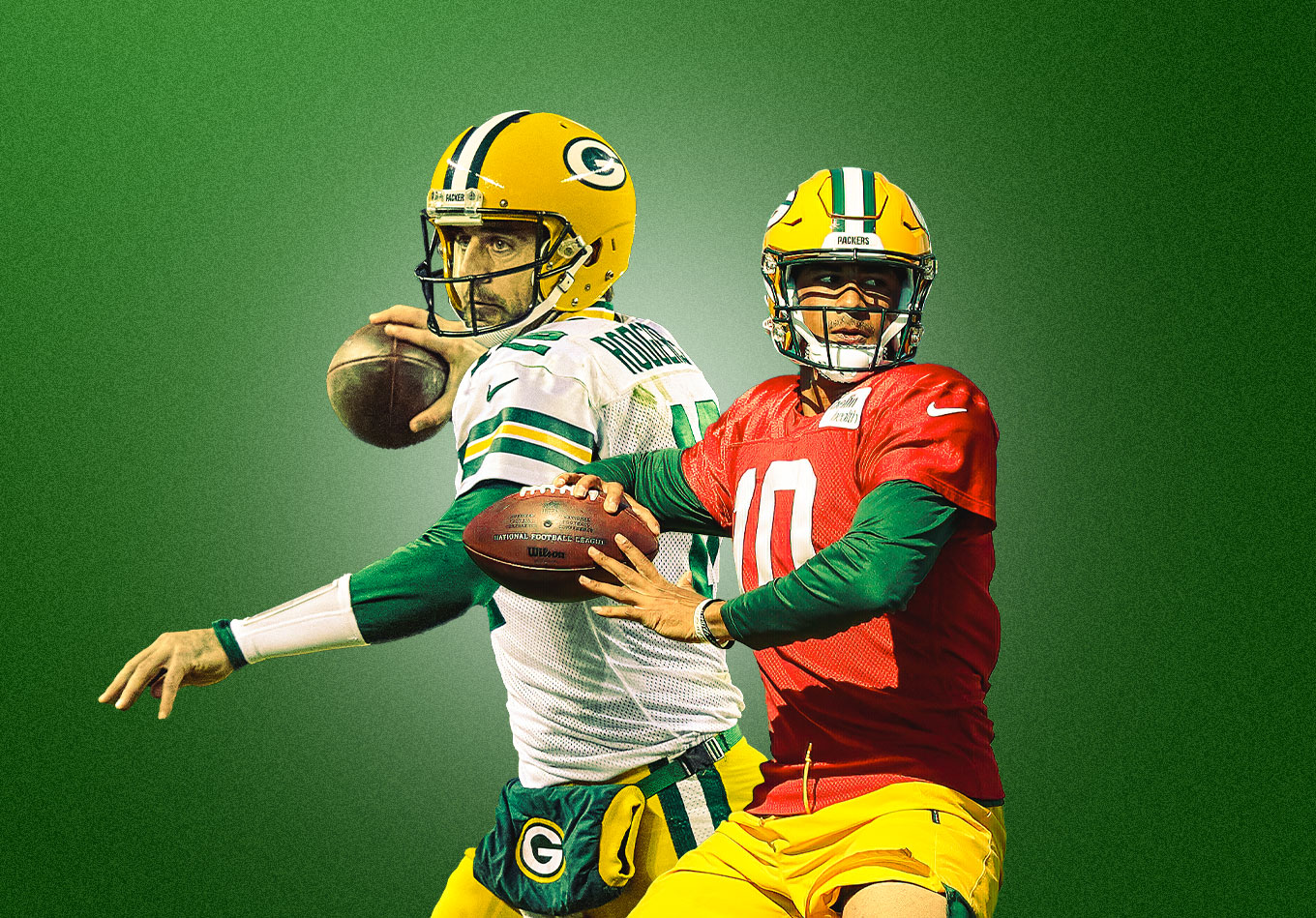“With my situation, look, it’s never been about the draft pick, picking Jordan.”
Aaron Rodgers broke his silence amid his stand-off with the Green Bay Packers this week after the saga cast a shadow over the NFL draft as his desire for a trade was revealed last month. The perennial NFC contenders have been left to start their preparations for the upcoming season without the league MVP, insisting his push to leave has nothing to do with them selecting his heir apparent, Jordan Love, in the first round in 2020.
“It’s just kind of about a philosophy and maybe forgetting that it is about the people that make the thing go,” Rodgers said on ESPN’s SportsCenter. “It’s about character, it’s about culture, it’s about doing things the right way.”
But whatever Rodgers’ reasons for his self-imposed exile, the reality for the Packers is that the longer this episode drags on, the more it becomes about Love and the potential drop-off from a future Hall of Fame quarterback to one who did not even suit up for a game as a rookie.
Just how precipitous could the decline in play from Rodgers to Love be if the three-time MVP does not return to play in 2021? Here’s a look at the challenge the Packers may face if they have to turn the keys to the offense over to Love in the coming season.
The Finest Hour?
Most quarterbacks in the NFL would struggle to live up to the standard Rodgers produced in 2020, as his skill set and Matt LaFleur’s offense – with its roots in the ultra quarterback-friendly Kyle Shanahan attack – coalesced to devastating effect.
Rodgers completed 70.7% of his passes – the highest mark of his career in seasons in which he attempted at least 200 throws – for 4,299 yards, 48 touchdowns and five interceptions. His TD-INT ratio of 9.60 was the second best of his career behind a 2018 season where he threw only 25 touchdowns and Rodgers outperformed each of his prior MVP seasons in 2011 (7.50) and 2014 (7.60) in that regard.
There is a case to be made, therefore, that the 2020 campaign was Rodgers’ finest to date, and it is one furthered by the advanced metrics. Rodgers’ well-thrown percentage (WT%), which measures how often a quarterback delivers an accurate, well-thrown ball, was 82.4 – third in the NFL behind Philip Rivers and Ryan Tannehill.
In other words, Rodgers’ completion percentage was no accident. He produced on-target throws at an extremely high rate and did an excellent job of avoiding turnover-worthy passes.
Indeed, Rodgers was also third in the NFL in pickable pass percentage (PKP%), which analyses how often a throw is interceptable by the defense. Only Alex Smith (2.12%) and Tom Brady (2.20) threw a lower percentage of interceptable passes than Rodgers (2.23).
Rodgers has not thrown double-digit interceptions since the 2010 season when he led Green Bay to Super Bowl glory, and he suffered only 19 sacks for negative yardage in 2020. At this stage in his decorated career, Rodgers possesses a masterful knowledge of how to maximize his offense’s potential to produce positive plays and limit defenses’ opportunities for game-changing takeaways.
Without any NFL experience, Love’s ability to do the same is questionable at best after a turnover-laden end to his collegiate career.

A Bet on Love
The Packers’ decision to trade up in the first round in 2020 to select Love as Rodgers’ eventual successor was a contentious one not just because they eschewed the chance to boost the supporting cast of wide receivers in a historic draft at the position. Planning for the future at the game’s most important spot is advisable but making that move for a quarterback coming off the 2019 season Love endured was always likely to raise eyebrows.
After an impressive 2018 in which he threw 32 touchdowns to just six interceptions for Utah State, Love experienced a hugely underwhelming 2019. Love’s 17 interceptions were the most in the FBS in a year that saw his touchdown total dip to 20, while his completion percentage of 61.9 was only good enough for 54th in the FBS.
And his struggles in connecting with his receivers and issues with turning the ball over were a consequence of Love’s consistent failure to produce accurate throws. Love’s 2019 WT% of 66.7 was well below the average of 73.2 for Power Five and Group of Five quarterbacks with at least 100 attempts.
Thirty-eight of his passes were considered interceptable, giving him a PKP% of 8.21 that was the third worst among signal-callers to meet that 100-throw threshold. When under pressure his WT% declined further to 54.9% and his PKP% increased to 12%.
A quarterback struggling when he feels the pressure is no surprise, but the shortcomings Love displayed when operating from a clean pocket and when under duress while playing against largely non-Power Five opposition makes the prospect of him facing NFL defenses after a season on the bench a very alarming one.
Should he start in 2021, Love will have the benefit of something he lacked during his final year at Utah State, a supporting cast capable of elevating his game.
The Supporting Cast
While much has been made of the lack of investment in Rodgers’ receiving weapons, whoever plays under center in 2021 will be playing with arguably the premier wideout in the NFL in Davante Adams.
His 1,374 yards were the second-highest single-season total of his career, while he led the league in yards per game (98.1) and receiving touchdowns (18). Adams also topped the charts in burn yards per route (3.9) among receivers to play at least 50 snaps in 2020.
The apparent telepathy Rodgers and Adams enjoy powered the Packers’ run to the NFC Championship game last season, but Marquez Valdes-Scantling also displayed intriguing progress.
With 45 burns – when a receiver wins his matchup with a defender on a play where he is targeted regardless of whether the pass is catchable or not – on 61 targets, Valdes-Scantling was eighth in burn percentage (73.8), second in burn yards per target (19.0) and fourth in big-play percentage (46.1) while recording the third-highest average depth of target (18.1) of all receivers with 50 snaps to their name.
Running back Aaron Jones was re-signed this offseason and could offer an extremely valuable safety net for a young quarterback. Jones has flourished in the zone-running scheme employed by LaFleur, posting a career-high 1,104 rushing yards and leading all running backs in yards before contact per attempt with 3.65.
Though Adams and Jones are unquestionably elite weapons, a lack of depth at receiver has long since been an issue. The third-round selection of Amari Rodgers this year was a belated attempt to address it but was obviously a pick made with giving Rodgers a dependable slot option in mind.
Rodgers’ incredible consistency in delivering accurate balls to all levels of the field has helped Adams to grow into one of the NFL’s most feared players at the receiver position and unquestionably played a role in Valdes-Scantling’s recent development.
With Love bereft of experience and the ball-placement proficiency that has contributed significantly to Rodgers becoming an all-time great, it is highly debatable whether he could build the same kind of rapport with Adams and Valdes-Scantling or help Amari Rodgers quickly blossom in the slot.
The Packers are a team for whom the Super Bowl has frustratingly proven a step too far in the past two years. Rather than enabling them to take that leap in 2021, a switch from Rodgers to Love is more likely to put them in reverse in the short term. For Green Bay to realize the potential of a loaded roster, it is imperative Rodgers is the first to blink in this most public of staring contests.
Design by Matt Sisneros.
